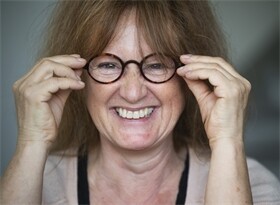Cops Against Community: Police Impunity and The Baltimore Uprising
Posted by the Bookshop

Read an essay by independent journalist Anjali Kamat, taken from the book Policing the Planet: Why the Policing Crisis Led to Black Lives Matter (Verso). On Tuesday 25 October join us for a panel discussion with book editors Jordan T. Camp and Christina Heatherton, as well as Adam Elliott-Cooper, a teaching fellow in the Department of Sociology at the University of Warwick, and Laleh Khalili, Professor of Middle East Politics at SOAS. They will discuss race and the police, the rise of Black Lives Matter and strategies for resistance. Book tickets now
On May 1, 2015, a small tense crowd standing across from Baltimore’s city hall erupted in hoots and cheers, quickly followed by tears and warm embraces. Marilyn Mosby, the newly elected state’s attorney, had just announced criminal charges against all six police officers involved in the death of twenty-five-year-old Freddie Gray. In a city rife with unsolved murders, it wasn’t his death that was novel. But the possibility that his alleged killers — the police — might be brought to justice was remarkably unusual. Between 2010 and 2014, 109 people died in police custody in Maryland, and criminal charges were brought against police officers in only two of the cases. In a city governed with impunity, Mosby’s announcement was a significant victory.
Raw emotions spilled onto the streets. For the rest of the weekend, the run-down West Baltimore intersection of Pennsylvania and North Avenues, the site of tense clashes with heavily armed riot police just days before, turned into the epicenter of spontaneous citywide celebrations. A system that had betrayed the hopes of generations of African Americans seemed, at long last, to be responding to the demands of a popular movement: “To the people of Baltimore and demonstrators across America, I heard your call: No justice, no peace!” Mosby declared. Of course, everyone knew the charges might be dropped and that the powerful police union could still win their case, but for one brief moment, the customary cynicism and pain were set aside. The mere prospect of justice felt like a benediction. And that Sunday, longtime community activist Reverend Heber Brown, III, titled his electrifying sermon at Pleasant Hope Baptist Church “This Can’t Be Real!”
Gray was a well-loved young man who grew up in the dilapidated Gilmore Homes projects in Baltimore’s poorest Black neighborhood, Sandtown-Winchester. Life here is precarious by design; decade upon decade of residential segregation, criminalization, and neoliberal economic policies have entrenched inequality and elevated every social indicator to levels far above the national average. With 20 percent unemployment and 31 percent poverty, one in four juveniles has experienced arrest, one in four buildings is abandoned, lead paint violations are four times higher than the citywide rate, and the rates of domestic violence, shootings, and homicides are among the highest in the city. Deindustrialization, compounded by disinvestment, the crack epidemic, displacement through urban renewal programs, and the subprime mortgage crisis decimated the wealth and wellbeing of communities like this. While the city poured hundreds of millions of dollars into redeveloping its harbor district and building new sports stadiums to attract tourists, neighborhoods like Sandtown-Winchester were left to rot. Since 1991, funding for programs supporting young people in Baltimore — recreation centers, parks, libraries, summer jobs, and afterschool programs — has been either frozen or slashed. In the same period, by contrast, the budget of the Baltimore Police Department tripled, and tax subsidies to corporations have increased. One glaring exception to the disinvestment in poor communities is incarceration: Maryland allocates $17 million a year just to incarcerate people from Sandtown-Winchester in state prisons.
Indeed, for residents of Sandtown-Winchester, there was no shortage of reasons to be enraged by a system that showed them little respect. But it was Gray’s arrest — moments of which were captured on a cellphone camera and went viral — and his subsequent death a week later that sparked a spontaneous rebellion that would come to be known as the Baltimore uprising.
When Gray died on April 19 from a spinal cord injury sustained in police custody, all the anger and sadness that had built up for years in this deeply divided city exploded. Gray’s friends rushed to the local police station demanding answers, and in the days that followed, hundreds and then thousands of people — seasoned community organizers and first-time protesters alike — took to the streets in response to yet another Black man dead after an encounter with the police. The city’s initial response appeared tone-deaf: the officers involved in Gray’s arrest were placed on paid leave, and, as the protests swelled, the police focused on safeguarding Baltimore’s symbols of wealth and power — Inner Harbor, Camden Yards, and City Hall.
The breaking point came on April 27, hours after Gray was laid to rest. Just as the school day was ending, riot police appeared in full force near the working-class Mondawmin Mall, citing rumors on social media about a gang truce and an alleged plot to attack the police. Dominique Stevenson, an activist with the American Friends Service Committee who lives across the street from the mall, described the police presence to me as a “clear provocation.” When the police shut down the public transportation system near the mall, effectively preventing students from getting home, the tinderbox exploded.
By that evening, Sandtown, as it is known locally, was on fire, with police cars, a drug store, and various storefronts set ablaze. Politicians denounced the violence as a riot that needed to be controlled immediately: the governor called in the National Guard, the mayor declared a curfew, and the media largely focused on the looting of liquor and drug stores and the cost of the property damage. But for people who lived and worked in the community, many of whom — elders, church leaders, activists, and gang members alike — instantly came together to try and contain the violence, it was an understandable, if regrettable, outburst by a generation brought up on despair and systemic neglect. “It was the community saying we’ve had enough,” Brown told me, as we sat in a small garden outside his church. The protesters were not, he emphasized, “thugs” or “criminals,” as the mayor and President Obama had initially described them. “We’ve been down in Annapolis, we’ve been at the city council, trying to get reforms. We’ve pursued every one of the avenues we’re told to pursue in order to see changes come about. And we’ve gotten nothing significant. It’s unfortunate that only after buildings were burned and cars were smashed, only then did people start listening,” he said.
On May 6, 2015, Baltimore mayor Stephanie Rawlings-Blake announced that she had requested the Department of Justice to initiate a civil rights investigation into the “patterns and practices” of the Baltimore Police Department, citing the “fractured relationship” between the police and the community and the need to restore trust in the police. The mayor’s announcement was welcomed, but many wondered why it had taken so long. After all, the breakdown in trust between the police and Baltimore’s African American community hadn’t begun with Gray’s death.
In Sandtown, unsurprisingly, opinions of the police have been overwhelmingly negative for as long as people can remember. Gray’s friends, some of whom started having run-ins with the police as early as middle school, laughed bitterly when I asked if they trusted the police. “Their job isn’t to protect us; it’s to come here and arrest us,” said Brandon Ross, Gray’s godbrother. “If they wanted to protect us, how do we have all these murders?” Another friend complained that the majority of the officers seem to be skilled only at humiliating, harassing, and beating people up. A third complained that most officers are outsiders, rather than members of the community they police; speaking over the loud din of the police helicopters circling overhead — an almost constant presence in the skies above Sandtown — he compared them to an occupying force. Indeed, only a quarter of the city’s police officers live within city limits, and that number is even lower (13 percent) for white officers.
Living in a high-crime neighborhood notorious for its drug markets is like being in a fishbowl, Ross said. People like him don’t have a fighting chance when it comes to questioning police tactics: “It ain’t cops against robbers. It’s cops against the community.”
Police harassment and abuse in Baltimore aren’t restricted to the city’s poorest neighborhoods. Across the city, many African Americans have experienced unnecessary police stops and searches, unexplained harassment and abuse, and even illegal arrests. Abdul Jaami Salaam is a youth counselor who lives with his wife and three-year-old son on a quiet treelined street near Morgan State University. He was stopped in 2013 by two plainclothes policemen while driving home with his toddler and a trunk full of groceries. Officers Nicholas Chapman and Jorge Bernardez-Ruiz dragged him out of the car, threw him to the ground, beat him, and kept him in jail for forty-eight hours—allegedly for not wearing his seatbelt. Salaam filed a complaint with the Internal Affairs division of the police department but never received a response.
Two weeks later, the same two officers were patrolling the streets in the same neighborhood and pulled over an unlicensed cab operator named Tyrone West. West didn’t submit easily after being dragged out of the car by his dreadlocks; a scuffle ensued, West was pepper-sprayed, and nearly a dozen more officers appeared on the scene, one of whom sat on West’s back until he was no longer breathing. The police report claims he died of a heart attack. West’s family members, bolstered by eyewitness statements, have refused this explanation and accuse the police of covering up a murder. Since West’s death, his sister Tawanda Jones, an elementary school teacher, has led weekly protests calling for an independent investigation into her brother’s death and for his killers to be prosecuted. Two years later, the family is still waiting. Meanwhile, Officers Chapman and Bernardez-Ruiz are still on the force.
Few in Baltimore are more familiar with the uphill battle for justice than Jones’s and Salaam’s attorney, A. Dwight Pettit, Jr. Pettit has sued dozens of police officers for misconduct and excessive force and estimates that his city leads the country in per capita incidents of police violence, owing in part to the lack of accountability for police abuse. When pushed, the city prefers to settle and, since 2011, has paid over six million dollars in over 100 police misconduct claims. The errant officers themselves, however, rarely pay a price for their actions. According to Latoya Williams, a lawyer at Pettit’s firm, the Baltimore police have “literally no one to answer to” and are rarely taken off the force in response to abuse complaints.
The scale of the crisis goes far beyond a few bad officers. Pettit and Williams blame the widespread abuse on a “culture of lawlessness” within the police department that worsened markedly during the tenure of Mayor Martin O’Malley (1999–2007), who imposed a broken windows–style “zero tolerance” policy. As part of the war on drugs, police were empowered to make mass arrests for small violations. The rate of arrests was so high that nearly one in six Baltimore residents was arrested in 2005 — 100,000 people arrested in a city of 640,000. This policy, according to Pettit, led to sweeping arrests without any probable cause and created a systemic attitude among the police that they “did not have to adhere to the constitution.”
Maryland state delegate Jill Carter, who represents West Baltimore and has often been the lone voice in Annapolis advocating police reform, agrees with Pettit, describing O’Malley as “savagely wrong on criminal justice issues.” At the height of enforcement of the zero-tolerance policy, it was common, according to Carter, for police to go to working-class African American neighborhoods and simply arrest everyone they saw outside. According to the ACLU, in 2010, 92 percent of arrests for marijuana possession in Baltimore were of African Americans, even though rates of marijuana use are roughly equal among whites and Blacks. The police department evaluated officers’ performances according to how many arrests they made, Carter explains, under the theory that “the more people we arrest, the less crime there will be, because no one will be on the streets.” The results are unsurprising: an explosive rise in incarceration, a generation growing up with criminal records, the dismantling of communities, the shattering of trust in the police, and a police force trained to focus on the quantity and not the quality of arrests.
“Numbers, number, numbers. They’re so skewed on the numbers game in Baltimore, you’re never going to get quality arrests, you’re never going to get anybody above street level.” Joe Crystal is a former detective in the Baltimore Police Department’s elite counter-narcotics unit. We were lying prone on the rooftop of a tall residential building looking over a low-rise housing project across the street. This was one of Crystal’s surveillance spots, where he would spend hours watching small drug deals and waiting to see if it could lead him to somewhere bigger.
“Look, over there, you see those guys on the corner? And the other guy walking towards them? Watch closely.” Crystal wanted to show me how easy it was to spot a deal from this vantage point. Within minutes there was an exchange and the man who had approached left quickly. “See? I told you! They always walk faster after a deal, that’s how you know.” We watched as the man disappeared down a narrow path and then behind a corner, his pace hastening with every step. He wouldn’t waste time arresting anyone here, Crystal said. “Wait and watch and investigate, that’s policing, not this numbers game.”
Crystal, the son of two New York City police officers, joined the Baltimore Police Department in 2008 and rose quickly through the ranks. He loved his job and the pace of life in Baltimore and was an avid fan of the HBO’s The Wire. But in September 2014, he was forced out after blowing the whistle on police misconduct. On October 27, 2011, Crystal had watched a veteran sergeant allow an off-duty officer to take Antoine Green, a small-time drug dealer they had just chased down and arrested, out of the police van and back into the house where they had apprehended him. There he heard the officer beat the handcuffed Green and watched as they brought him back out, disheveled and limping. When Crystal complained to another sergeant, he was warned to stay silent and told that his career “wouldn’t be worth shit” if he snitched. But Crystal couldn’t let it go. This wasn’t the kind of policing he wanted to do.
He spoke to a friend at the State’s Attorney’s Office, and the two of them pressed charges. Over the next two and half years, Crystal was routinely harassed and threatened by his colleagues, treated like a pariah for snitching, and abandoned by the police union (who chose instead to publicly defend the sergeant whose misconduct he had reported). When he called for backup, his calls were ignored. Someone left a dead rat on his car. The message was clear, and after a jury found both the sergeant and the officer guilty, Crystal and his wife moved as far away as they could. They now live in rural Florida, and Crystal works as a security guard for a fraction of the pay he got in Baltimore.
Crystal has no regrets, and his experience has made him empathize with people in Baltimore who don’t trust the police. “I can relate,” he said, adding that testifying against the police was the scariest thing he’s ever done. “Across the board, there’s no accountability: they just turn a blind eye and sweep things under the rug.”
Crystal is a rare breed: a cop with a conscience, and one who’s willing to pay a heavy price for breaking the infamous blue wall of silence. He’s the kind of cop people on the streets of Baltimore respect and admire and many would love to have return. But while scanning every visible corner of the housing project, tracking the movements of people from twenty floors above and seeking discernible patterns in their actions, even Crystal viewed everyone in the crosshairs of his binoculars as an object of suspicion.
A car pulled up on the far corner; a man approached it deliberately and leaned casually over the driver’s window. A few minutes later a young child ran up to the man by the car, and then back into a building. “He’s probably the runner, delivering the drugs,” Crystal said. At that moment an elderly couple emerged from the car, arms full of grocery bags, and walked into the projects. “Oops,” he said, as his eyes settled on a new target. He pointed to the right at two boys sauntering down an empty sidewalk, patches of green sprouting up through its cracks. “Those two, I’ll bet they have something on them. Look at how they’re walking. Like they’ve got something to hide.”
Crystal emphasized that he would never arrest anyone simply based on these unsubstantiated suspicions. But he’s seen police in Baltimore arrest people on less, he said, what with the pressure on officers to get as many arrests as possible. And his candid reactions to the people on the sidewalk below were an unexpected window into the zero-tolerance style of policing, demonstrating how easily a community can be stripped of all nuances and framed in a single, unforgiving light.Doing police work in Baltimore (as in most American cities) still relies on the broken windows model and, as a result, the hyper-surveillance of one community in particular: working-class African Americans. When the police are trained to watch for certain suspicious behaviors, and they primarily watch people from one community, and those behaviors considered suspicious include walking too quickly or standing for too long, sitting alone too quietly or hanging out too noisily with others, driving too fast or running too suddenly, then every move made by members of this community can easily conjure up the subtext of a larger drug deal, the context for an unfolding crime, a pretext for arrest, probable cause.
This is how an entire community can be criminalized, and could reveal in part why Gray was chased down, beaten, “folded up like a pretzel,” and arrested outside the Gilmore Homes on that fateful morning of April 12, 2015, when all he had done was make eye contact with a police officer and then run as fast as he could.
The tragic death of Freddie Gray and the uprising it spawned exposed so much of the systemic racism, inequality, and police violence in Baltimore to national scrutiny that it has created small but significant openings for change. The six police officers involved in Gray’s death were formally indicted in June 2015, despite a smear campaign against Mosby’s charges by the police union. When Attorney General Loretta Lynch visited Baltimore to investigate the police department, grassroots activists working to end police brutality, including Tawanda Jones and Heber Brown, met with her. Whereas in the spring of 2015 the Maryland state legislature rejected seventeen bills introduced by Delegate Carter to reform the criminal justice system and reduce the oversize influence of the police union, there appears, at the start of 2016, to be an appetite for some modifications. But until the broader culture of police impunity and the systematic criminalization of Black lives is addressed and changed, alongside a fundamental transformation of the economic priorities of the city to remedy the deep structural inequalities in Baltimore, the broad constellation of factors leading to the rebellion remain unchanged. Perhaps it will soon be time for another uprising.
Book tickets to see Jordan T. Camp and Christina Heatherton, editors of Policing the Planet: Why the Policing Crisis Led to Black Lives Matter, do a panel discussion with Adam Elliott-Cooper and Laleh Khalili.




